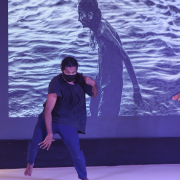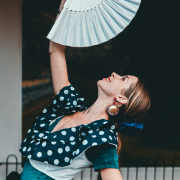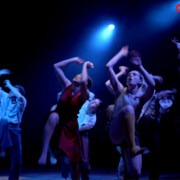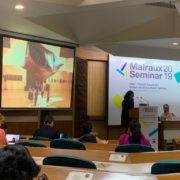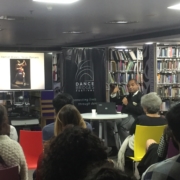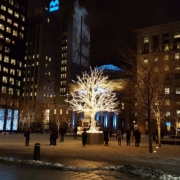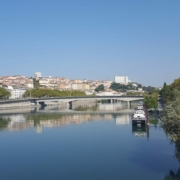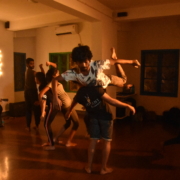Political Mother Unplugged: Live stream by Théâtre de la Ville – Paris
Political Mother Unplugged – Hofesh Shechter – Live YouTube
“Political Mother” is ten years old. Let’s discover it again in a new, unplugged version imagined for the young dancers of Shechter II.
Broadcasted live on Théâtre de la Ville YouTube and website, from Théâtre de la Ville – Les Abbesses (without audience) // Duration 1h
Watch “Political Mother Unplugged” live by clicking on the following link at the scheduled time https://bit.ly/Political_M_web
Hofesh Shechter scrutinises again this stunning show with the talented international young dancers of Shechter II. In a landscape of animated digital projections, the choreography unfolds in a world of raw emotions and powerful sensations triggered by the compelling and tribal movement of the group. A unique dance experience that leaves no one indifferent.
Live Streamings are free of charge, and accessible on the TDV website, at the time of the performance only.
Saturday, December 26 at 4PM (Paris) 8:30PM (India)
Tuesday, December 29 at 9PM (Paris) Wednesday December 30 at 1:30 AM (India)]
Saturday January 2 at 11AM (Paris) 3:30PM (India)
Sunday January 3 at 10PM (Paris)
Do join us for this amazing performance and invite your friends too!
Supported by British Council France, Dance Bridges Festival, One Dance Week, Context Festival and Saitama Arts Theatre.
Indo-French Malraux Seminar 2019-2020
Dance Bridges represented by Festival Director, Vanessa Maria Mirza was pleased to be a part of the Malraux Seminar organized by the French Institute in India. An excerpt from a report by Institut Francais (New Delhi, India) of the meetings in September 2019 and May 2020. Download the full report here. India expresses an ongoing interest for urban issues, public spaces and artistic involvement in these areas, offering France an interesting opportunity of cooperation and exchange. France has a real expertise in designing artistic projects in public spaces, as demonstrated through festivals and other initiatives mainly led by public authorities. While cultural operators in India also develop creative and innovative projects across the territory, they still face many difficulties and constraints related to the complex and multidimensional nature of public spaces. To this end, the Malraux Seminar aimed to be a platform for encounters and dialogue, bringing together Indian and French stakeholders from practitioners, architects, urbanists, academics and cultural project managers to Government officials. The two-day symposium inquired into public art interventions, its challenges, and actions necessary to guide urban art projects forward. As smart city initiatives progressively consider art in its policy making, the conference created an open conversation to collectively discuss resources and best practices. The proceedings broke the intricacies of sustainable Public Art projects into 3 main themes with 5 roundtables. Public art is influential in creating a more vibrant and participatory urban space. The case studies presented opened an exchange on making art that is more inclusive, and forging partnerships to enable financial or in-kind support. Such artistic manifestations reanimate interest in a city and augment global interest and tourism. As public art projects bring back forgotten legacies and lesser known districts on the cultural map,there is a need for greater education and exposure for all the stakeholders who conduct such interventions, from the grassroot level to the state authorities. Due to the Covid-19 crisis, several of the Seminar’s conclusions have been challenged and many questions and issues raised on the future of art and culture in a post-pandemic public space. Taking off from the 5 original ones, a virtual round table was organised in May 2020 that brought together all the participants to share their experiences, thoughts and concerns on both the current situation and the future of public art projects in a post-covid world. This final exchange raised several points on urban public art, and a lot of food for thought in anticipation of the future.
Contemporary ART+ Performance, a talk with Anirudh Chari
Dance Bridges had the pleasure to co-present with the British Council Kolkata an interactive session on Contemporary ART + Performance focussed on contemporary artists in the UK led by Kolkata based curator and cultural theorist Anirudh Chari. The talk was followed by a session of improvisation looking at art as a point of departure for inspiration in choreography and performance. It was an enjoyable evening and we are grateful to all those who joined us for this event.
Read about this wonderful evening with The Telegraph t2. Read the full article online here.
” ‘Chari gave us great insights into the effect and impact dance had had on some modern/contemporary artists working in different mediums of painting, print, sculpture, photography, among others. I was able to lead dancers in the audience in an improvisation after, looking at the reverse connection, exploring how art can influence dance and choreography in different ways,’ said Vanessa Mirza, director, Dance Bridges Festival. “
CINARS Biennale 2018
‘Since 1984, every two years in Montreal, CINARS has been organizing one of the most important international showcases and networking events, gathering more than 1 900 professionals hailing from over 54 countries including 433 show presenters, some of whom are the most influential in the business. During one week, 170 shows from Quebec, elsewhere in Canada, and abroad grace the stages while workshops, networking events, as well as an exhibition hall are teeming with participants in some of Montreal’s main cultural venues.
After 18 editions, the CINARS Biennale has made a name for itself as a must-see multidisciplinary event in which participants can develop real international touring opportunities, build solid relationships with stakeholders from all over the world, and sharpen their professional skill set and knowledge base.’
– CINARS Biennale (www.cinars.org/en/biennale)
Dance Bridges was at the 18th edition of CINARS Biennale 2018 in Montreal, Canada for an amazing week of performances, presentations and discussions. Festival Director Vanessa Maria Mirza was also invited to speak in the The Great Knowledge Cafe session with the theme ‘The Art of Building bridges around the world’. This was a wonderful activity hosted by CINARS & CAPACOA as a unique and dynamic platform of learning, transforming and networking. It was an excellent time of exchange led by Dance Bridges( Kolkata) & Open Look (St.Petersburg). ‘CINARS was a great experience’,says Vanessa, ‘and I look forward to more international and particularly Canadian partnerships and collaborations being built through this event.’
Encountering French Artists & the dance & art of Paris & Lyon
An article by Vanessa Maria Mirza, Founder-Director, Dance Bridges Festival, attending the Biennale de la Danse in Lyon and other performances and artist meetings in Paris.
‘It was indeed a great delight for me to be invited as an international delegate for the 18th edition of the Biennale de la danse, Lyon supported by Institut Francais, ONDA and Maison de la Danse. I share here some of the highlights of my visit for a two-week period in Paris and Lyon. It has been a very enriching experience that has not only inspired me personally but also proved very useful in making connections to build future collaborations with Dance Bridges (Kolkata).
The Focus Danse and Biennale de la Danse was one of the best dance platforms/festivals I have seen so far. I appreciated that the performances were curated across a wide range of spaces and theatres and I got to see many different performance venues. It was the first time for me to see many well-known French choreographers like Jerome Bel and Maguy Marin but also I was glad to see work from many young emerging and mid-career artists. Both in Lyon and later in Paris, I was impressed by the broad concept of dance that was reflected in the performances I saw, the use of digital technology, staging and visual elements and also the amazing skills and abilities of the performers.
It was inspiring and intriguing at the same time. Rachid Ouramdance’s work ‘Franchir La nuit’ performed at the Lyon Opera House was really beautiful, especially with the way he choreographed the piece using young dancers. Yoann Bourgeouis’ ‘Histories Naturalles 24 Tentatives, D’Approaches D’Un Point de Suspension’ performed at Musee Guimet, was also stunning in the techniques used and ideas explored, woven within a
tightly knit choreography.
In Paris, I enjoyed very much watching Israel Galvan’s brilliant ‘Gatomaquia’ (a flamenco solo performed in a circus tent and incorporating the Romanian gypsies from the circus into this version of the performance), Circe Plume ‘La Derniere Saison’ (a contemporary French circus in their last season performing with strong dramatic content, live music and exceptionally beautiful sets and lighting) and Maguy Marin’s ‘Cinderella’ performed by the Lyon Opera-Ballet Company (eloquent and fascinating in her interpretation of the story and particularly with the use of masques). I was also able to watch a number of interesting works at the Les Plateaux Festival at Theatre Jean Vilar and at La Briqueterie by mostly emerging artists.
At the Dansathon which I was able to attend on the last day of the Biennale in Lyon, I saw some very exciting presentations. The participants engaged with dance and technology in new ways using augumented and virtual reality to bring dance closer to the wider public. The prize winning project was ‘An Internet Connected Dance Space’ where through a mobile app, dancers at different points of the globe could dance at the same time and share in an experience with the help of digital media. We also saw videos of the simultaneous process that has taken place in London and Liege.While I don’t list all the names and artists here, I was able to watch about 26 different pieces through my visit, and it was absolutely fantastic for me both as an artist and programmer.
Through the weeks that followed both at the Biennale in Lyon and in Paris I was able to talk with many very interesting French and international choreographers and producers. It was lovely to see some artists who have been a part of Dance Bridges and some that we met at Aerowaves.
At the ONDA meetings I had the wonderful opportunity to be introduced to a number of artistic programmers from France and other countries that I was meeting for the very first time. The session I attended in Miribel on ‘Dance in Public Spaces’ was a very useful discussion to learn more about how other festivals and programmers have been working with artists in this area of performance in their own regions, while also getting know about many projects/artists who have interesting creations/research in this area. Later in Paris, I also had the pleasure of visiting the ONDA Office to meet with Regis Plaud to understand more about ONDA’s work with performing arts and also exchange information about Dance Bridges and my own projects in India.
It was a special privilege for me to have visit and tour a few venues for dance creation and performance including Theatre de la Ville, Parc de la Villete, La Briqueterie and Centre National de Danse in Paris. It was exhilarating for me to learn more about how things operate at each of these spaces, but also understand more about the design, concept and planning that went into each of them. I had many interesting conversations on how they engage with
artists and the community.
A favourite part of my time in France as a visual artist and curator was being able to visit many art museums, galleries and exhibitions. I have a strong interest in the Impressionists and so was very glad to see many beautiful Impressionist paintings at the Musée de l’Orangerie and Musee Montmarttan Monet. I also enjoyed the contemporary art collections at Centre Georges Pompidou which is such a fascinating space and I loved the gorgeous views of Paris at sunset. I was able to visit Musee Jacquemarte-Andre with a new exhibition on the Italian painter Caravaggio that was really exquisite and the first of its kind in Paris. I also had special visit to Cite de la musique with a tour by Philippe Bruguière at the Musée de la musique, showing us the rare and beautiful collection of musical instruments. In Lyon I was able to visit of Museum of Art and was so enthralled by their fabulous collection of artwork and art objects.
This trip wouldn’t have been possible without certain individuals taking an interest in the work I do and I would like to thank those who conceived and orchestrated this visit on very short notice. My deep gratitude to Claire Verlet, Alice Brunot & the Institut Francais team, Regis Plaud, Karthika Nair and Thomas Belus among many others for their kind and wonderful support in making this such a rich experience for me. I am truly changed by my time in France, and I know it will have a deep impact on my person and my artistic practice. Merci beaucoup!
Merging music and movement, on the spot with Kyle Scott
We had an inspiring evening with artist Kyle Scott, performing songs from recent albums and EP’s, sharing key moments that inspired his music and artistic journey and talking about his creative process in songwriting and music. Read an excerpt from Kyle’s interview with The Telegraph t2 by Yasmin Turner. Read the full article online here.
“An intimate dance studio at The Doodle Room in Garcia was the location of an exciting collaboration of dance and music between Dance Bridges Festival and American singer songwriter Kyle Scott on September 8. […]
When did you start writing and perfoming music ? Has this been something you’ve only done in Calcutta?
I started singing in my early 20s, playing in small venues around the stat of Indiana, where I’m from, but I’ve travelled back and forth, between the US and India for work on and off for about a decade. Since then, I’ve been plugging in to the music scene here in Calcutta. You kind of have to dig for it, but it’s here.
What influences your music – experiences or artistes?
Moving here has been a big piece of it and has introduced me to an entirely different culture, a beautiful culture. It’s sometimes overwhelming with the noise and the chaos of the city. I come from a farming community in Indiana, so it’s night and day as far as differences go! I love (singer-songwriter) Damien Rice and he’s been a big influence on my music. I like how his music kind of quiets and then takes off, then quiets down again. There’s a lot of emotion in the way that he composes.
So what does the future hold for you? More music?
I’m finishing my work here, with Sari Bari (a non-profit), and I’m heading back to the US at the end of the year but I’m recording a single soon. I’m usually kind if a loner when it comets music but I’m branching out with a band. I’m hoping after what we’re doing in the studio, this will be a kind of springboard to continue doing music in the States. I also want to take an Indian harmonium home, it’s such a cool instrument!”
You can watch a video snippet from the event here.
t2’s tryst with MR Twinkletoes — Stefano Fardelli
Artist interview with Stefano Fardelli for The Telegraph t2 by Anannya Sarkar. Read the article online here.
When we met Italian dancer Stefano Fardelli, he had just walked into The Doodle Room in Hazra with the swagger of a fashion model dressed in all black, his affability belying the fact that he had just been fleeced by a local cabbie on a trip to the Victoria Memorial on a scorching May afternoon.
“I really like the colonial buildings in the city and I am very curious to know more, even if I get fleeced a little on the way,” chuckled Stefano, a dancer who has made a name for himself in the contemporary dance sphere and is a guest teacher at The Place, a renowned dance school in London.
With a background in modelling, Stefano’s flair for style is not difficult to place. The contemporary dance style that he teaches — a mix of (Merce) Cunningham technique, floor-work, release technique, physical theatre and Feldenkrais technique — is an amalgamation of his personal experiences assimilated over almost three decades. Stefano, who has been regularly coming to India since 2013 as part of cultural exchanges facilitated by the Italian embassy, was brought to the city by Vanessa Mirza of Dance Bridges Festival for a workshop and that’s where t2 caught up with him.
From modelling to dance, how did you make the switch?
I have been dancing since I was six. But you know how Italy is really famous for its fashion, so my dream was to become a stylist. The dance that I was learning was commercial (jazz and funky) and at one point I decided to take it seriously and started studying ballet at a private school in Genoa. During my first year there, a choreographer selected me for a musical and that’s when I started considering it as an option.
I went to London at 15 and won a modelling competition and then won the Italian leg of another prestigious modelling competition. I then moved to Milan and I am one of the very few people in the world who is certified to teach “catwalk-ing”. But after a year, I auditioned for one of the most prestigious European dance schools for ballet and contemporary dance, where I was selected. After working in Europe for a while, I just sent my CV to The Place in London — it’s one of the most famous dance academies of the world — for teaching there and I was surprised that they called me. Once you’re a guest teacher there, all the other doors open up for you.
How did India happen?
In 2013, I was in India for a holiday and did the usual trail — Delhi, Rajasthan, Varanasi and Agra. Varanasi during the Kumbh Mela was magic and I fell in love with the city. I created a solo called Svarupa-Vyakta and that piece was really lucky as I won many prizes for that. I have also created a couple of other pieces that were inspired by this country like 98288 and Hugs in Space.
Every year, I come here to understand the country better and rediscover and enjoy. And then I take what I collect during these trips and create something from there and share with people. For example, in Hugs in Space, which will premiere in Luxembourg soon, I have been inspired by the difference in the approach to hugs in Europe and India. Hugs are not that common in India, especially between couples, while it’s quite different in Europe.
If you had to describe your style of dancing, how would you put it?
Contemporary dance is very difficult to explain because we have so many fusions now. In Europe, we say it’s better to enter the army than a dance academy because it’s that strict; this is one way of maintaining the high level we have.
We have to say that all contemporary techniques come from postmodern work in dance and that was mostly happening in America. In Europe we had the evolution of this, which is contemporary. Contemporary is release, it is floor-work and fusions with Tai Chi, yoga and Gaga (a method from Israel).
So what I do and what any contemporary choreographer does depends on their background. My background is Cunningham, floor-work, physical, release and the Feldenkrais technique.
What do you think are the struggles in the realm of contemporary dance in India?
In India, I meet a lot of talented dance students and there is a huge dance community. But unfortunately, you don’t have knowledge of the western techniques. You are really good at the eastern ones but knowledge of the western ones is the key required if you want the doors of the West to open up for you.
In Europe, we don’t give dance scholarships at all as that is our way of ensuring the highest standard. What I try to do when I meet someone really talented is that once a year I send students to Europe for a scholarship because I know that for most of the talented students here, it’s not easy to bear the European costs. I have sent six people so far and this year, I have permission to send 10 people. From their feedback, they’re doing well for themselves, meeting amazing teachers, earning money and they have a real chance of becoming dancers. For me, knowing this is enough because I don’t get much more out of this.
Where do you think the future of contemporary dance is headed?
Contemporary dance is a very personal technique as the choreographer collects the best from all they did in the past. Nowadays, people travel so much all over the world that they are getting inspired all the time and can add new fusion. So the time is great for contemporary dance and you cannot see the end till this fusion continues. There is a new way to do what you already do — therefore it is personal. Contemporary dance is inspired by anything and everything and there is no limit.
You can view the workshop trailer here
Iranian artiste Makan Ashgvari’s experiments with sound and words
Artist interview with Makan Ashgvari for The Telegraph t2 by Anannya Sarkar. Read the full article online here
As an electronic musician, Makan Ashgvari likes to weave his surroundings into his creative work, like the sound of trucks lumbering on the roads of Tehran where he lives. As an artiste, Makan refuses to be compartmentalised, and to help more such independence in the creation of arts, he founded Otaghkar in Tehran as a platform for independent music in 2013. In Calcutta as part of the Dance Bridges Festival, Makan talked about making music in the alternative space, his career trajectory and To Trucks, his latest album, when t2 caught up with him at The Doodle Room on Garcha Road.
Your latest album, To Trucks, makes use of ambient sounds and merges them with electronic progressions. Can you take us through the process?
Some people can be mad at me because I have distorted and destroyed some Iranian literature by changing the words, changing the orders of the lines of the poems and also mixing them together. So that’s not something you do to the classical Iranian literature as that’s the red line. The sounds I recorded while travelling, I distorted them, cut them, re-recorded them and transformed them. The sounds that I recorded while travelling are called Side A and I call the poems and songs that I borrowed from classical literature and transformed, Side B. So Side A is a geographic journey and Side B is a journey in time and I looked at my album as a tape, like you can play the other side. I hitchhiked a lot in Iran and while travelling I was seeing so many trucks on the road and even when I was back in Tehran — I would say a city so similar to Calcutta — I could also see trucks on the streets there, which was very odd. I thought that these trucks belong to the roads and not the city. The truck drivers treat the truck as a live person — for example, if you offer biscuits to a live person, they will say that the truck will be upset as the truck is like the host.
To the uninitiated, how would you explain what electronic music is?
I would say if you listen to a fluorescent, there is a noise, a sound; if you listen to a lamp, there is a sound. So for me the sound that goes through this process — it could be a nylon guitar, a sitar even, if it’s processed by these cables, it’s going to have this quality of electronic to it. But if you just listen to a singer without any microphone or speakers, that is acoustic music.
If you see MTV Unplugged, it’s a band you know, like Nirvana or Florence and the Machine, and they use acoustic instruments, still that has an electronic side to it as it’s going through amplifiers, cables and speakers. I don’t identify my music as electronic, you know. I think nowadays if you’re not listening to a sitar player in a room without a microphone and speakers, I think that’s the only acoustic music that exists. If it goes through a wire, it’s electronic.
Given that you are based out of Iran, what impact does the state have on your creativity?
It does, for sure. But this is also mostly unconscious. Like the first time I went to Europe, I understood that people don’t look at each other. And that was the first time I understood that in Iran, people look at each other. And, of course, there’s a political angle to it. It’s really various. For example, I sang Ain’t No Grave (most famously sung by Johnny Cash) and I added one verse: “When my mumma had me, There were bombs on Tehran, but now I am here, I am singing this song, I am here safe and sound, There ain’t no grave can hold my body down.” I think this verse fits into that American song and I think that I can have this similarity to an American artiste also. So it’s not only about your geography and your land. It has so many aspects.
Who are some of your influences in music, theatre and dance?
Nina Simone is definitely an influence —her diversity and her personality as someone who cares about what’s going on in the world. Also, Farhad, the Iranian singer. John Cage is an artiste with no limits and whose works I have performed. All my teachers have been great influences too.
Your poetry and lyrics have received praise. What do you set out to express when you write?
I don’t really think of that. A song is my thinking — the way my mind works sometimes. Like when you talk to yourself, you don’t really think of what to say. But of course in the process of editing, things might change. And so many of my songs come to life while improvising with others.
What are some of the struggles and benefits of being an alternative artiste in the 21st century?
The most important benefit is the Internet, which I think by mistake we musicians see as a thread, because sometimes we believe that every single product should be sold directly to the audience. We have to acknowledge the power of the Internet and appreciate it as a tool. The struggle is that of being focused. So many options, tools and facilities can confuse you sometimes.
“I think the audience enjoyed Makan’s innovative sound, visual presentation and the stories behind his creative process. It was on a very short notice that this project came into being” — Vanessa Mirza, director, Dance Bridges Festival
You can view the highlights of the artist talk here

